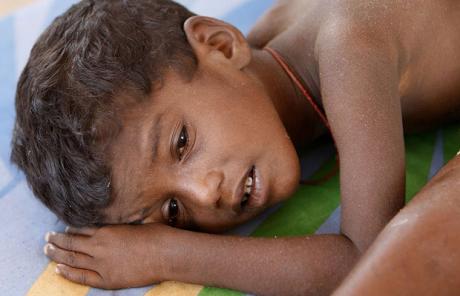
Ilankai Tamil Sangam
Association of Tamils of Sri Lanka in the USA
Published by Sangam.org
by Dean Nelson, The Telegraph, UK, May 24, 2010
|
The disclosure of thousands of severely maimed and disabled civilian victims contradicts the claims of Sri Lanka's president Mahinda Rajapaksa, who has said his army rescued 280,000 "hostages" without any civilian casualties. The injured are being held in hospitals throughout the country and camps in the north which are off-limits to journalists and open only to a small number of specialist aid workers. |
Up to 30,000 Tamil civilians have been left severely disabled by Sri Lankan army shelling in the so-called 'no-fire zone', it has been revealed.
 |
A sick child lies on a bed at a hospital in Manik Farm displaced persons camp in Vavuniya Photo: KIRSTY WIGGLESWORTH/AP |
Aid workers said one in ten of the 280,000 civilian refugees who fled the Sri Lankan army's final onslaught against the Tamil Tiger rebels had either lost limbs or been so badly injured they urgently needed prosthetic limbs or wheelchairs to regain their mobility.
The scale of civilian casualties who have been maimed in the war was disclosed by the award-winning French charity Handicap International, which works with the victims of war throughout the world.
The charity, which has a small factory producing artificial limbs in Batticaloa in Sri Lanka's eastern province, has opened an emergency unit at one of the centres for people who fled the fighting, and is working with other suppliers to meet what it described a "huge demand".
Aid workers said nearly all of the people had been the victims of relentless Sri Lankan shelling of the civilian safe zone, where the last of the Tamil Tiger leadership made its last stand before it was wiped out last week.
The disclosure of thousands of severely maimed and disabled civilian victims contradicts the claims of Sri Lanka's president Mahinda Rajapaksa, who has said his army rescued 280,000 "hostages" without any civilian casualties.
The injured are being held in hospitals throughout the country and camps in the north which are off-limits to journalists and open only to a small number of specialist aid workers.
Handicap International's Sri Lanka director Satish Misra said the number of maimed could be "about 25,000 to 30,000 people".
He said he had established an emergency centre at Vavuniya last year in anticipation of the demand, and that a team of specialist physiotherapists and occupational therapists were now working with the victims.
Their work has been hampered by a government ban on refugees leaving the camp which means the wounded cannot be taken to his factory in Batticaloa, on the eastern coast, where new artificial limbs are fitted and the patients are trained in their use.
"We can't start fitting the prosthetic yet because it's difficult while the people are not allowed out of the camps. The limbs must be fitting and people must be trained how to use them," he said.
One aid worker who has visited the refugee camps told the Daily Telegraph he had been shocked by the number of displaced civilians who had lost limbs in the recent fighting.
"We know of one person who lost his leg and his wife lost both her legs. They have an eight month old baby. They left the baby in the bunker to get food and were shelled when they came out. They are in Vavuniya camp," he said.
The conditions there and at other restricted camps in the north were the worst he had seen in a 20 year career of helping refugees in war zones around the world, he said.
Old people had died because they had lost their families and could not fend for themselves in the camps, while many children were alone without relatives to care for them. Many children were emaciated, he said, and skin diseases were widespread.
"There are 6,000 people in Polmoddai Camp. They're destitute, arrive in just the clothes they're wearing and put in tents which are excruciatingly hot. The camp is in the jungle, and there have been five people bitten by snakes. The camps at Vavuniya have open sewers, and have become a marshy mass of excrement.
"There are seriously injured people sent to camp in these unhygienic crowded conditions," he said.
Meanwhile, the Tamil Tigers acknowledged for the first time that their leader had been killed by the Sri Lankan army.
Velupillai Prabhakaran, 54, was reported to have died last week in a last stand by the rebels and his body was displayed by the army.
Selvarasa Pathmanathan, the head of international relations for the Liberation Tigers of Tamil Eelam (LTTE), said in a statement released on Sunday: "We announce today with inexpressible sadness and heavy hearts that our incomparable leader, the supreme commander of the LTTE, attained martyrdom fighting the Sri Lankan government."
The admission came as Father Amalraj, a Roman Catholic priest who was inside the no-fire zone until the day before the Tigers announced their surrender, gave an annount of the terror of living under the constant shelling.
"The people were targets for both side", he told the Times.
"There was heavy shelling from the army side. The LTTE shot people. The army were trying to capture us. The people were caught in between in the last moment for the LTTE and the crucial point in the battle for the army. I cannot say which side was crueller."
People in the zone had cowered in improvised bunkers built on the beach for weeks on end to escape the shelling, he said.
"The shelling was just like raining.
"Within this two square kilometres, there were more than 100,000 people, packed in and shells raining down."
© 1996-2025 Ilankai Tamil Sangam, USA, Inc.